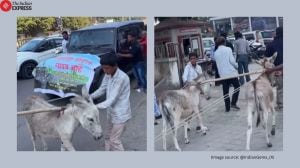Breathing new life into old maps
The University of Richmonds Digital Scholarship Lab has added modern bells and whistles to the landmark Atlas of the Historical Geography of the United States.
In 1932,when Charles O Paullin published his monumental Atlas of the Historical Geography of the United States,reviewers were overwhelmed by its nearly 700 maps covering seemingly every facet of the countrys social,economic and political life.
But the atlas,by its creators admission,was missing one thing: motion. The ideal historical atlas might well be a collection of motion-picture maps, Paullins editor,John K Wright,wrote in the introduction,if these could be displayed on the pages of a book without the paraphernalia of projector,reel and screen.
Historians and everyday Internet time wasters have long since become used to animated maps,covering topics ranging from a four-minute recap of the Civil War to the global distribution of tweets about Beyoncés new album. Now,modern bells and whistles have also come to Paullins atlas. A souped-up online version has just been released by the University of Richmonds Digital Scholarship Lab,bringing what historians consider a work of unsurpassed scope into the age of the iPad.
Paullins maps covered so many topics that theres really something for everyone, said Robert K Nelson,the director of the Digital Scholarship Lab.
Paullins atlas was hailed in 1932 for the imaginative ways it showed change. The new sites digital enhancements bring that sense of movement to further life,allowing users to pull up the fine-grained data behind many maps (most of which have been georectified,or warped to align accurately with a modern digital map).
We live in history the way fish live in water, said Edward L Ayers,the founder of Digital Scholarship Lab and a senior consultant on the project. Its invisible to us,but a historical atlas can give us a sense of coherence of the larger pattern.
The digital Paullin arrives at what seems like a fortuitous moment. Recently,scholars have paid increasing attention to the spatial aspects of history,using sophisticated Geographic Information Systems technology to reveal previously unseen patterns of change.
In the 19th century,maps became a new kind of tool,not just a way-finding device, said Susan Schulten,a historian at the University of Denver. Instead of just showing geographical features,works like Francis Walkers 1874 Statistical Atlas of the US the first national atlas in the world based on census data layered different kinds of information onto the landscape.
Paullins atlas,published nearly 50 years later,was a culmination, Schulten said,of that new statistical cartography. Dozens of researchers,assembled by the Carnegie Institute,spent nearly 20 years culling and plotting out data from census records,newspapers,local archives and other far-flung sources.
There were some 50 historical maps going back to 1492,and more than 600 new maps,beginning with the environment and moving on to territorial expansion,settlement patterns,slavery,spread of churches and universities,and shifts in wealth distribution.
Place names were largely omitted to keep the focus on broader patterns. One map shows shifts in the geographical centre of the nations population,both as a whole and broken down for whites,blacks and immigrants.
The digital Paullin is only a prelude to the Richmond groups next effort: an entirely new digital atlas,to be completed over a decade. This Paullin for the 21st century,will update some aspects of the earlier work Paullins treatment of Native Americans,Nelson said,was pretty horrible.
The atlas will also cover the last 80 years of history,including topics like the Interstate Highway system,the civil rights movement,growing US military power and the rise of the Internet.
A historical atlas enfranchises the nation, Ayers said. Anyone can look and say that even here,in some history-less suburb,this was part of the unfolding.”































